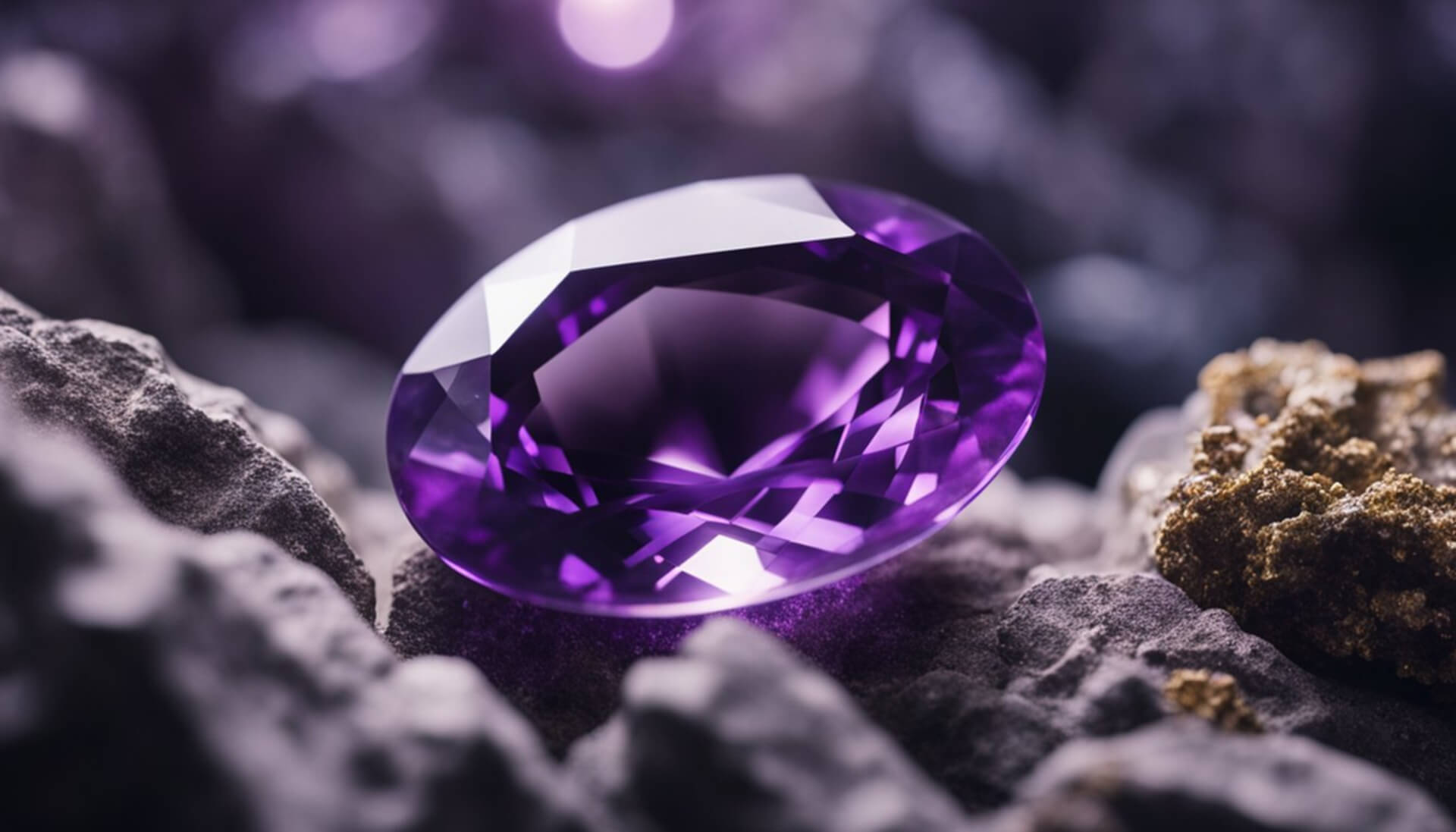February, the second month of the year, is often associated with the purple hues of amethyst, its recognized birthstone. Amethyst is a variety of quartz highly esteemed throughout history for its stunning beauty and legendary powers to stimulate and soothe the mind and emotions. Its rich color spectrum, from light pinkish violet to deep purple, makes it a favorite among jewelry enthusiasts and collectors.
Known for its striking appearance, the February birthstone is also attributed to various spiritual and therapeutic qualities. Historically believed to prevent intoxication, today, amethyst is thought to promote clarity and is often used in meditation. Moreover, its widespread popularity is evidenced in its use across various cultures, where it adorns everything from royal crowns to ecclesiastical jewelry.
Overview of Amethyst
Amethyst, the iconic purple quartz, has been esteemed throughout history for its striking beauty and alleged mystical properties. As the traditional February birthstone, this gemstone signifies power and carries a rich heritage dating back to ancient civilizations.
Historical Significance
The name ‘amethyst’ originates from the Ancient Greek word ‘amethystos’, which means “not intoxicated”. This origin speaks to the ancient belief that the stone could protect its wearer from drunkenness—a myth likely associated with the wine god Bacchus. The ancient Greeks and ancient Egyptians adorned themselves with amethyst, also featured in the British Crown Jewels, underscoring its association with royalty. Amethyst has been used throughout history to craft beads, carvings, and other decorative objects, indicating its integral place in various cultures.
Amethyst Properties
Amethyst is a purple variety of quartz and is distinguished for its hues ranging from light lavender to deep violet. Known for its durability (Mohs hardness of 7) and ubiquity, amethyst is a favorite among gemstone enthusiasts and jewelers alike. It has a trigonal crystal system and can be transparent or translucent.
Here’s a brief table outlining its properties:
| Property | Description |
| Color | Ranges from light lavender to deep purple |
| Hardness (Mohs) | 7 |
| Crystal System | Trigonal |
| Luster | Vitreous |
| Transparency | Transparent to translucent |
| Refractive Index | 1.544 – 1.553 |
The natural occurrence of this purple gem in various parts of the world further contributes to its widespread appreciation and usage in jewelry.
Geological Formation

The February birthstone, amethyst, is coveted for its vibrant purple hue and formed through a dynamic natural process involving natural irradiation and iron impurities.
Amethyst Formation
Amethyst is a variety of quartz that acquires its signature purple color from the presence of iron within its crystalline structure and the subsequent exposure to natural irradiation. It often forms in hollow, gas-filled cavities within volcanic rock or geodes, which can take millions of years to evolve. The depth of purple can vary from a light lavender to a deep violet, largely dependent on the concentration of iron and the level of radiation it has been exposed to.
Predominant Mining Locations
Brazil and Uruguay are two of the most significant producers of amethyst. Vast deposits are often found in geodes within volcanic rocks, and the amethyst geodes can grow to impressive sizes in these regions, sometimes weighing several tons.
Zambia is another notable contributor, supplying a substantial quantity of high-quality amethyst to the global market.
Other countries such as Canada, Russia, India, and parts of Africa also harbor amethyst deposits, providing diverse qualities and sizes. The geological conditions of these locations influence the uniqueness of their respective gemstones, with variations in color and clarity.
Physical and Optical Properties
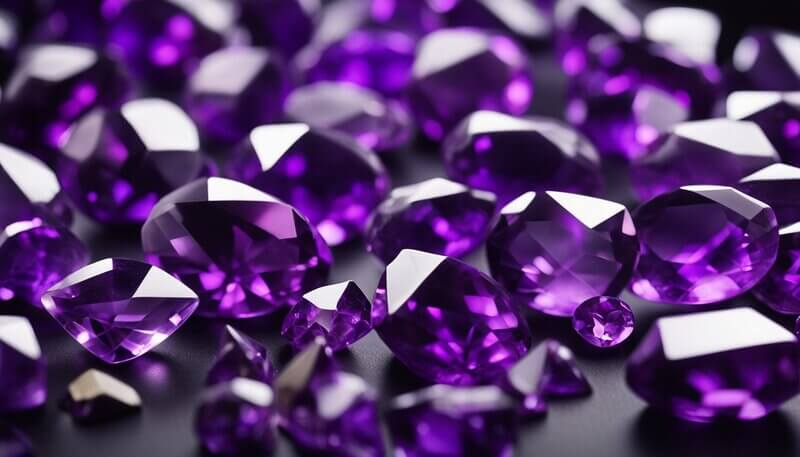
Amethyst, the esteemed February birthstone, boasts an array of physical and optical characteristics that captivate gem enthusiasts and jewelers alike. These gems are known for their beauty and consistency in quality and durability.
Color Variations
Amethyst is renowned for its striking purple color, ranging from pale lilac to deep violet. Iron impurities within the quartz structure, coupled with natural irradiation, generate the purple hue. The color can extend to reddish purple, and may also exhibit pleochroism—showing different shades, such as red and blue, when observed from various angles. There are even unique variations like ametrine, which is a naturally occurring form that blends the purple of amethyst with the yellow or orange of citrine.
Crystal Structure and Hardness
Amethyst crystallizes in the trigonal system and is a variety of quartz, making it a mineral with a silicon dioxide composition. This structure imparts the gem with a considerable degree of hardness, measuring 7 on the Mohs hardness scale, which makes it suitable for everyday wear in jewelry. Its natural resilience to scratching is a key factor in its perennial popularity.
Transparency and Clarity
Typically, amethysts exhibit transparent to translucent clarity. The level of transparency can affect the perceived color intensity and brilliance as light passes through the gemstone. Inclusions are common but can be minimal; they are often types of crystal growths or liquid inclusions. Some amethysts may appear almost colorless in low-grade forms, while high-quality stones are expected to have no eye-visible inclusions and exhibit rich color saturation.
Spiritual and Therapeutic Attributes

February’s amethyst birthstone is deeply entwined with spiritual significance and reputed therapeutic benefits. Recognized for its calming influence and ability to promote mental clarity, this purple gemstone plays a significant role in both healing practices and spiritual ceremonies.
Buy Orgonite Pyramid – Amethyst Crystal
Healing and Psychological Effects
Amethyst is often employed in practices aimed at protection and strength building. As a stone of wisdom, it is believed to foster quick wit and a clear head, particularly when one might otherwise feel drunkenness or confusion.
Its supposed calming properties are said to alleviate stress and soothe the wearer, helping maintain mental health and passion with a sense of love and well-being.
Amethyst and Spirituality
Spiritually, amethyst is linked to the crown chakra, considered the gateway to higher states of consciousness and spiritual connection.
This purple quartz is frequently used to enhance spiritual awareness and open up channels for wisdom. It is also cherished for its symbolic association with love, deeply rooted in the spiritual quest for higher understanding and connection. The gem’s rich hue symbolizes deep passion, making it a fitting gift for expressing love without succumbing to emotional drunkenness.
Amethyst in Jewelry
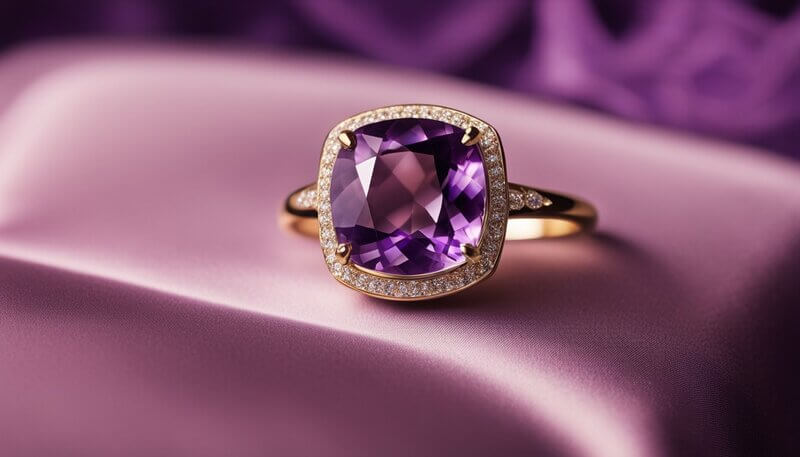
Amethyst, a striking gemstone recognized for its captivating purple hue, is a popular choice for various types of jewelry. This gemstone, ranging from light lavender to deep violet, is known for its hardness and suitability for everyday wear.
Rings and Earrings
Amethyst gemstones are frequently featured in rings and earrings, which can be set in gold or silver to accentuate their rich color.
Jewelers often cut amethyst into various shapes, including traditional rounds and ovals and more contemporary cuts like cushions or princesses. The stone’s durability, rating a 7 on the Mohs scale of hardness, makes it suitable for pieces like engagement rings that are worn daily.
Necklaces and Bracelets
Necklaces and bracelets often showcase amethyst in larger cuts, highlighting the stone’s natural beauty.
Amethyst can be cut into faceted gemstones for a refined look, or shaped into smooth cabochons for a soft, elegant appearance. This versatility allows amethyst jewelry to range from elaborate, multi-stone pieces to simple, understated designs.
Jewelry Care and Maintenance
Amethyst jewelry requires proper care to maintain its luster and prevent damage.
Owners should avoid exposing amethyst to extreme heat and direct sunlight, which can lead to fading due to irradiation effects. To clean, use gentle soap with lukewarm water and avoid harsh chemicals. Regular check-ups with a jeweler are advisable to ensure settings remain secure.
Cultural and Symbolic Meanings
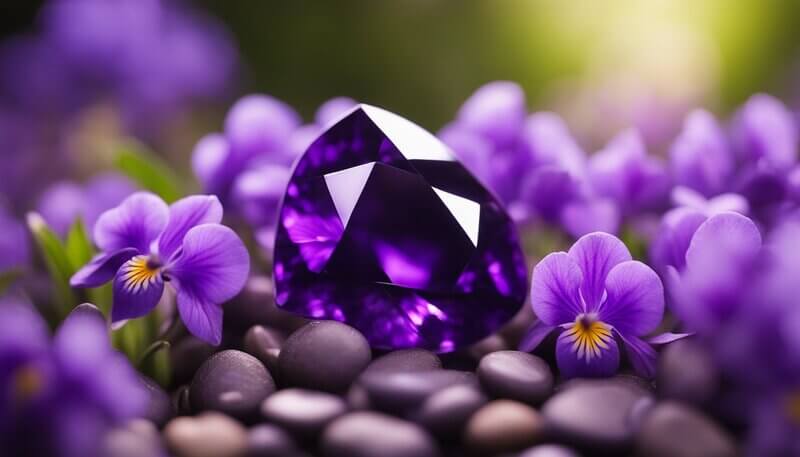
February’s amethyst birthstone has a rich tapestry of cultural and historical significance that permeates many aspects of lore and modern symbolism.
From its association with royalty to its reputed protective powers, amethyst’s mystical color and rare beauty have solidified its status in cultures around the world.
Amethyst in Lore and Legend
Amethyst’s legend begins with ancient Greece, where it was believed to prevent intoxication—so much so that the name amethyst derives from the Greek word “amethystos,” meaning “not drunk.”
This gemstone also has a deep connection to the wine god, Bacchus, with folklore suggesting it could protect one from the god’s wrath.
Within Ancient Egypt, amethyst was valued as an amulet with protective properties, often worn by travelers or carved into heart-shaped amulets for burial with the deceased.
Similarly, in Christian tradition, St. Valentine was said to have worn an amethyst ring carved with the likeness of Cupid, symbolizing the stone’s association with love.
Modern Birthstone Significance
Amethyst holds its place as the February birthstone, closely linked with the zodiac signs of Aquarius (Jan 20 – Feb 18) and Pisces (Feb 19 – Mar 20).
For Aquarians, the stone is thought to enhance their natural traits like independence and intellect, while for Pisces, it brings clarity to their emotional intuition.
As a symbol of serene wisdom, purity, and calm, amethyst is often gifted as a token of love and said to strengthen relationships and bring courage to those celebrating birthdays within this month.
Furthermore, the gemstone’s regal violet hue continues to be recognized as a mark of royalty and elegance.
Orgonite Pyramid – Amethyst Crystal
Amethyst Varieties and Related Gemstones
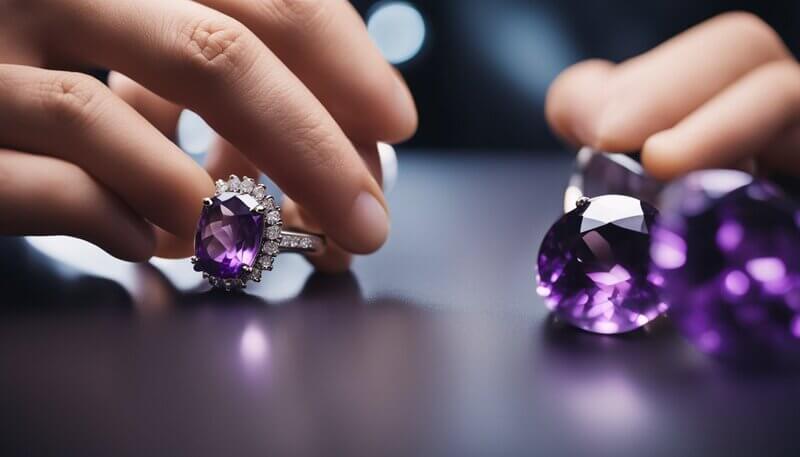
Amethyst, the quintessential February birthstone, is esteemed for its captivating range of colors and occurrence in various engaging forms, including pure varieties and hybrids with other quartz types.
Color Variation and Hybrids
Amethyst gemstones primarily exhibit hues from light, pinkish violet to deep purple. The presence of iron impurities and irradiation contribute to these color variations.
Uniquely, ametrine is a natural hybrid showcasing zones of purple amethyst and yellow citrine within the same crystal, often found in Bolivia.
Amethyst can also transition to green when heat-treated, a variety known as prasiolite, despite being rare.
Another heat-induced transformation can occur, turning amethyst into a yellow or orange variety, resembling citrine.
Notable Varieties and Comparisons
- Purple shades of amethyst can be compared with colored sapphires, although sapphires are harder on the Mohs scale and generally more valuable.
- Although not commonly known, red and pink amethysts can be likened to rubies and garnets in appearance. However, rubies are more vividly red due to their chromium content, and garnets are typically less transparent.
- Rare blue or green amethysts have no direct relation, yet their color can be compared to aquamarine or green sapphires.
- Black amethyst, a rarity, contains inclusions or cavities that make it appear darker and can sometimes resemble black diamonds or jaspers in color but not in brilliance and structure.
In both natural settings and jewelry, the value of amethyst is determined by its color and clarity, with few inclusions or cavities being more desirable.
Amethyst’s relatively high hardness (7 on the Mohs scale), availability, and versatility make it a popular choice for all types of jewelry.
Value and Pricing

The value of the February birthstone, amethyst, varies widely, reflecting its availability in various qualities. This section details how the value is determined and the gemstone’s potential as an investment.
Determinants of Price
Clarity, carat weight, color, and cut are key factors influencing the price of amethysts.
Typically, higher-clarity gemstones command higher prices than those with higher carat weights.
The color of amethyst ranges from pale lilac to deep purple, with saturated hues prized most.
A well-executed cut can enhance the stone’s brilliance and, thus, its value.
Amethysts are assessed by jewelers and priced accordingly, with market demands also affecting overall valuations.
Prices may range from modest for common qualities to thousands of dollars for top-grade stones, as detailed in the Most Valuable Birthstones ranking.
Investing in Amethyst
Investing in amethysts can be appealing, but it requires market knowledge.
Premium gemstones with exceptional clarity and deep color may appreciate over time, but investors should know that not all amethysts will yield a return.
As with any gemstone investment, factors such as rarity, demand, and gemstone quality influence potential appreciation.
It’s often recommended to seek pieces from reputable jewelers to ensure authenticity and value.
Sourcing and Ethical Considerations

In the context of February’s birthstone, sourcing and ethical considerations have become paramount. Given the environmental and social impacts of mining, consumers and retailers alike are pushing for more ethical practices in obtaining gemstones, including amethyst, the primary birthstone for February.
Responsible Mining Practices
Brazil and Zambia are significant producers of amethyst, a quartz gemstone valued throughout history for its striking purple hue.
Mining operations in these countries and other areas across South America and Africa are increasingly scrutinized for their ethical and environmental practices.
These enterprises must abide by responsible mining practices, which include following legal frameworks, upholding labor rights, and minimizing environmental harm.
They aim to ensure sustainability by restoring mined land, reducing water pollutants, and maintaining biodiversity.
Mining ethics also involves fair wages and safe working conditions for miners.
As part of the South American mining community, Bolivia is also working on reinforcing these standards to meet the demand for ethically-sourced gemstones without compromising the welfare of its people and their environment.
Synthetic Amethyst and Imitations
Synthetic amethyst provides an alternative to natural gemstones and has implications for sustainability and ethics.
Created in laboratories, synthetic amethyst has the same physical and chemical properties as its natural counterpart but eliminates the need for disruptive mining activities.
Consequently, it offers a more environmentally friendly option for consumers.
However, the market also contains imitation stones, which may resemble amethyst but do not share its properties.
Transparency in labeling and marketing these products is vital to prevent consumer deception and to promote informed decisions.
Frequently Asked Questions
This section addresses common inquiries about February’s birthstone, clarifying its traditional form, color associations, popular jewelry choices, accessibility for non-birth month individuals, intriguing trivia, and its value compared to other gemstones.
1. What is the traditional birthstone for the month of February?
The traditional February birthstone is amethyst, a variety of quartz known for its striking purple color. Its stunning beauty and legendary powers have been highly esteemed throughout history.
2. What color is typically associated with February’s birthstone?
February’s amethyst birthstone is typically associated with a range of purple shades, from light lavender to deep violet. The richness of its hue can vary, which is part of its unique charm.
3. Which gemstone is commonly gifted in the form of a necklace for February birthdays?
Amethyst necklaces are a popular choice for February birthdays. They are often chosen for their enchanting purple color, which is both captivating and versatile.
4. Can you wear a February birthstone if you were not born in that month?
One should not be born in February to appreciate or wear amethyst jewelry. Amethyst’s allure transcends birth months, making it a beloved gemstone by many for its beauty and supposed healing properties.
5. What are some lesser-known facts about the February birthstone?
Lesser-known facts about the February birthstone include its historical value comparable to rubies and emeralds and its symbolic ties to love and spirituality. Amethyst’s availability has increased, but it remains prized for its beauty.
6. How does the February birthstone compare to other months regarding value and rarity?
Compared to other months’ birthstones, amethyst is relatively abundant. This makes it less expensive. However, high-quality amethysts, especially those with deep color saturation, can still be valuable.

